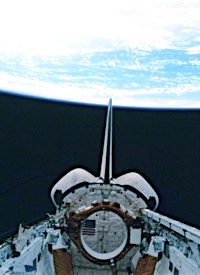
President Obama’s proposed changes to NASA’s plans for manned space flight have implications for many aspects of the aerospace industry. Following the recommendations of the Augustine Committee, Obama decided to essentially terminate his predecessor’s plans for resuming manned flights to the Moon, and an eventual mission to Mars. Now his administration’s move toward privatizing space flight is drawing aerospace giant Boeing into the space tourism market.
Touted as encouraging a ‘free market‘ approach to manned space flight, Obama’s vision has been for NASA to purchase seats on private space vehicles, supposedly not unlike the military buying seats on commercial airline flights to move U.S. soldiers rather than flying them in governmented-owned aircraft.
Obama’s new approach to manned space flight has come at a time when new aerospace companies such as SpaceX are attempting to break into the market for lower cost launches to low earth orbit (LEO). And the prospect of lower cost launches means that companies such as Virgin Galactic offering opportunity for “space tourism” are being taken more seriously.
The concept of “space tourism” has long been considered one way of developing a new market for less expensive launch capacity to LEO. The idea is that private individuals will be willing to spend significant amounts of money for the ability to engage in the ultimate form of adventure travel, and at present the minuscule space tourism market forms the only privately-funded alternative to flights in which governmental authorities select and train astronauts.
Space tourism has certainly tended to have a "giggle factor," which was only accentuated when Cirque du Soleil founder Guy Laliberte became the seventh such "tourist." However, the decision of aerospace giant Boeing to actively pursue space tourism may go a long way toward causing industry analysts and the general public to take it more seriously. According to a New York Times article,
Boeing — which is developing a capsule it hopes will take NASA astronauts to the International Space Station and on Tuesday was awarded a five-year, $1.2 billion extension of its contract with NASA covering engineering work on the station — announced that it will offer for sale any seats that NASA does not need. Boeing officials said their first flight is aimed for 2015.
The entrance of an aerospace giant like Boeing perhaps marks the transition of space tourism from a fanciful pursuit of startup entrepreneurs to a mainstream aerospace market.
"We’re ready now to start talking to prospective customers," said Eric Anderson, co-founder and chairman of Space Adventures Ltd., a Virginia-based space tourism company that would market the seats for Boeing.
If Boeing’s proposed capsule, the CST-100, is used by NASA to carry American astronauts to the International Space Station, the scheduled flights will include seats for non-government "paying customers." Again, according to the New York Times:
Current NASA plans call for four space station crew members to travel on each flight. The Boeing capsule, called the CST-100, would have room for seven, leaving perhaps three seats available for space tourists.
The Boeing approach to space tourism would thus heavily rely on a consistent stream of astronauts, but would still allow for a dramatic increase in the number of seats available for those who can afford to pay for the trip. Given the competition which other companies (such as Virgin Galactic) would offer for the potential "tourist" market, the new frontier in travel seems likely closer than ever before.
At present, Congress is considering which course to pursue in determining the future of manned space flight, weighing the traditional approach of government-owned rockets carrying astronauts and payloads to orbit, versus the proposed option of contracting space on commercial flights. As the Times article states the case:
The competing vision, embodied in President Barack Obama’s 2011 budget proposal for NASA, focuses instead on nurturing private companies that want to develop the space equivalent of airlines. NASA would then simply buy seats on those rockets to send its astronauts to the International Space Station.
Competition, the thinking goes, would drive down the cost of getting to space, leading to a profitable new American industry and freeing more of NASA’s budget for the deep-space missions.
The ability of private companies to continue to expand the utilization of LEO is what is immediately at stake in such congressional deliberations, but the future of manned space flight beyond the immediate environs of the Earth is less certain. The tendency of administrations to fundamentally alter the long-term visions of human exploration of the solar system has proven to be not only wasteful of government funds, but also a hindrance to the very process of exploration NASA is supposed to be pursuing.



